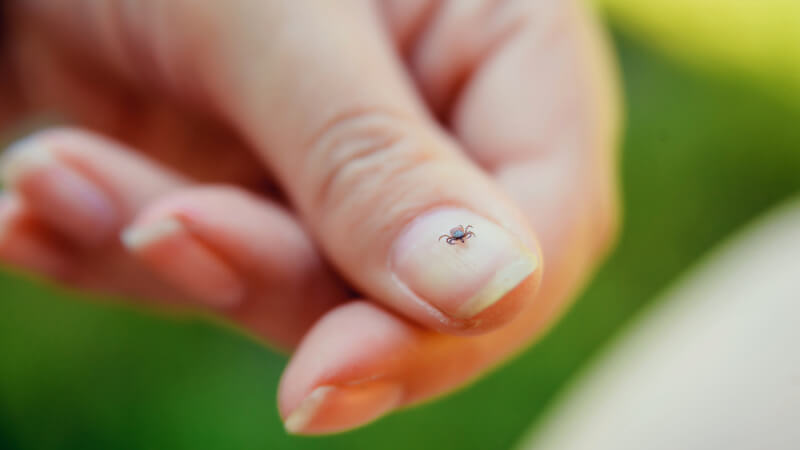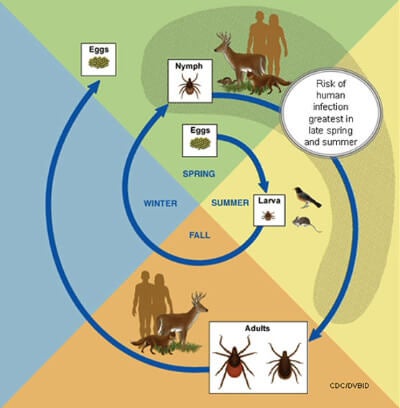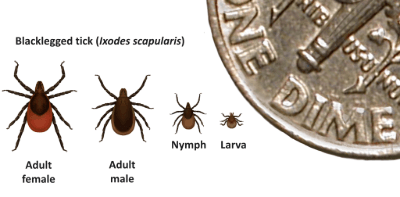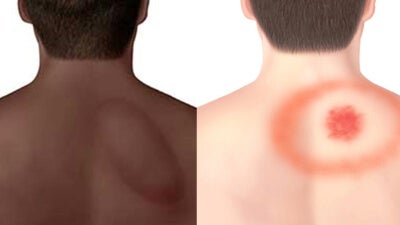Tick Season Alert: Facts About Anaplasmosis, Babesiosis, and Lyme Disease
July 18, 2025
Categories: Bassett News
Tick-Borne Illnesses Are on the Rise Locally
Bassett Healthcare Network is working to raise awareness about the risk of tick-borne disease in our local area, urging residents to take meaningful precautions to avoid tick bites and seek prompt medical care if they are bitten and suspect they may have contracted a tick-borne illness like anaplasmosis, babesiosis, or Lyme disease.
The New York Center for Agricultural Medicine and Health (NYCAMH), an affiliate of Bassett Healthcare Network, has prepared a brochure detailing all of the basics. Click here if you would like to download it.
Ticks may be active year-round, but the risk of human infection is greatest from late spring through the summer. Together, we can ensure our family members, friends, and neighbors are aware of the risks so they can take action to hopefully avoid severe symptoms or other complications.

What is Anaplasmosis?
Anaplasmosis is a disease spread through a specific type of bacteria that may be in a tick’s saliva when it bites. A person who has contracted it may experience fever, chills, headache, muscle pain, nausea, or stomach pain after a bite. If you have these symptoms and you may have been bitten by a tick, it is critical that you seek medical testing and treatment promptly. Unlike Lyme disease, anaplasmosis is not likely to cause a rash.
If it is not treated, it can lead to more severe symptoms, potentially including difficulty breathing, kidney or other organ failure, neurologic problems, bleeding, or death.
Anaplasmosis is primarily spread by the blacklegged tick, otherwise known as the deer tick, which is common in our local area. Click here to see photos and diagrams of the blacklegged tick from the University of Rhode Island’s TickEncounter program what can help you identify it.

What is Babesiosis?
Babesiosis is a rarer disease than anaplasmosis, but it’s increasing in prevalence in our region. It’s caused by microscopic parasites that infect red blood cells. It is primarily transmitted by the bite of a blacklegged tick, but can also be transmitted human to human via blood transfusion or from a mother to her baby during pregnancy.
Babesiosis may result in no symptoms for the person who’s contracted it or flu-like symptoms, possibly including fever, chills, headaches, body aches, loss of appetite and nausea, or fatigue. It can also lead to a specific type of anemia, a condition in which a person does not have enough healthy red blood cells.
What is Lyme Disease?
Lyme disease is a disease spread through a specific type of bacteria that may be in a tick’s saliva when it bites. It is also primarily spread by the blacklegged tick.
Early symptoms can include fever, chills, headache, fatigue, muscle aches, swollen lymph nodes and the tell-tale EM (Erythema migrans) rash, which typically begins at the site of a tick bite anywhere from several days to a month after the bite. The EM rash may look like a bull’s eye, but it doesn’t always.
If left untreated, Lyme disease can lead to facial palsy, severe or intermittent joint pain, nerve pain, swelling in the knees or other joints, nerve pain, episodes of dizziness or shortness of breath, irregular heartbeat, or inflammation of the brain and spinal cord.

How Can I Prevent Tick Bites?
The best way you can reduce your risk of contracting a tick-borne disease is to reduce your risk of being bitten in the first place. People who work outside or otherwise spend a lot of time outside are most at risk of tick bites.
- Use EPA-registered insect repellents that contain DEET or picaridin, which can be purchased at most general merchandise retail locations.
- Consider treating clothes, socks, and shoes with permethrin (an insecticide) before wearing them outside. A University of Rhode Island study showed that people who treated their shoes and socks with permethrin were nearly 74 times less likely to be bitten by a tick. Permethrin can be purchased at most farm supply and hardware stores.
- Ticks will be easier to spot on light-colored clothing. Consider choosing a long-sleeved shirt and long pants, particularly if your outdoor activity is happening in a wooded, grassy area.
- Check yourself for ticks often. Ticks tend to attach in dark, moist places, like behind the ears, in the hair or along the hairline, in the armpits, in the elbows or at the back of the knee joints, and in the groin area.
- Shower when you come in from time spent outside. Putting clothing in the dryer on high heat for 20 minutes can also kill ticks.
- Check dogs and cats for ticks immediately after they’ve spent time outside. They can carry ticks into your home that can then bite you or them. Speak with your veterinarian about tick prevention products for your pets, like collars, topicals, or chewables.
What Should I Do If I Am Bitten?
If you find a tick attached to the body, it is important that it is removed as soon as possible. Prompt removal can reduce the risk of contracting many tick-borne diseases.
Using tweezers, grasp the tick as close to the skin as possible. Have someone help if the tick is in a place that is difficult to reach. Pull the tick away with steady pressure without twisting.
After you have removed the tick, monitor your health for at least the next 30 days. If you begin to see a rash or experience flu-like symptoms, seek prompt medical care.
This video from the New York State Department of Health demonstrates how ticks can be safely and effectively removed.
What Can my Bassett Healthcare Network Practitioner do to Help?
Your Bassett Healthcare Network healthcare provider can perform blood tests to determine whether you have contracted a tick-borne disease and prescribe treatment if you have.
Anaplasmosis can be detected through the bacteria itself or its antibodies. Lyme disease diagnosis requires the presence of antibodies, so it can take several weeks for a Lyme disease test to come back as positive. Both anaplasmosis and Lyme disease are treated with the same antibiotic, so if they exist as co-infections, they can be treated at the same time. Babesiosis is treated with different medications.
Patients treated in the early stages of these diseases usually recover completely. If you suspect you may have contracted a tick-borne disease, reach out to your Bassett primary care practitioner’s office for guidance or visit one of Bassett Healthcare Network’s Convenient Care locations. Convenient care appointments can be scheduled in advance, but walk-ins are also welcome.
